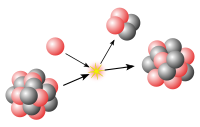
Photo from wikipedia
We build and train an artificial neural network (ANN) model based on experimental α-decay energy (Qα) data. In addition to decays between the ground states of parent and daughter nuclei,… Click to show full abstract
We build and train an artificial neural network (ANN) model based on experimental α-decay energy (Qα) data. In addition to decays between the ground states of parent and daughter nuclei, decays from the ground states of parent nuclei to the excited states of daughter nuclei are also included. In this way, the number of samples is increased dramatically. The α particle is assumed to have a spherical symmetric shape. The root-mean-square deviation between the calculated results obtained from the ANN model and the experimental data is 0.105 MeV. It shows a good predictive power for α-decay energy with the ANN model. The influence of different inputs is investigated. It is found that both the shell effect and the pairing effect result in an obvious improvement of the predictive power of the ANN model, and the shell effect plays a more important role. The optimal result can be obtained when both the shell and pairing effects are considered simultaneously. The application of the ANN model in predicting α-decay energy indicates a neutron magic number at N=184 in the superheavy nuclei mass region.
Journal Title: Symmetry
Year Published: 2022
Link to full text (if available)
Share on Social Media: Sign Up to like & get
recommendations!